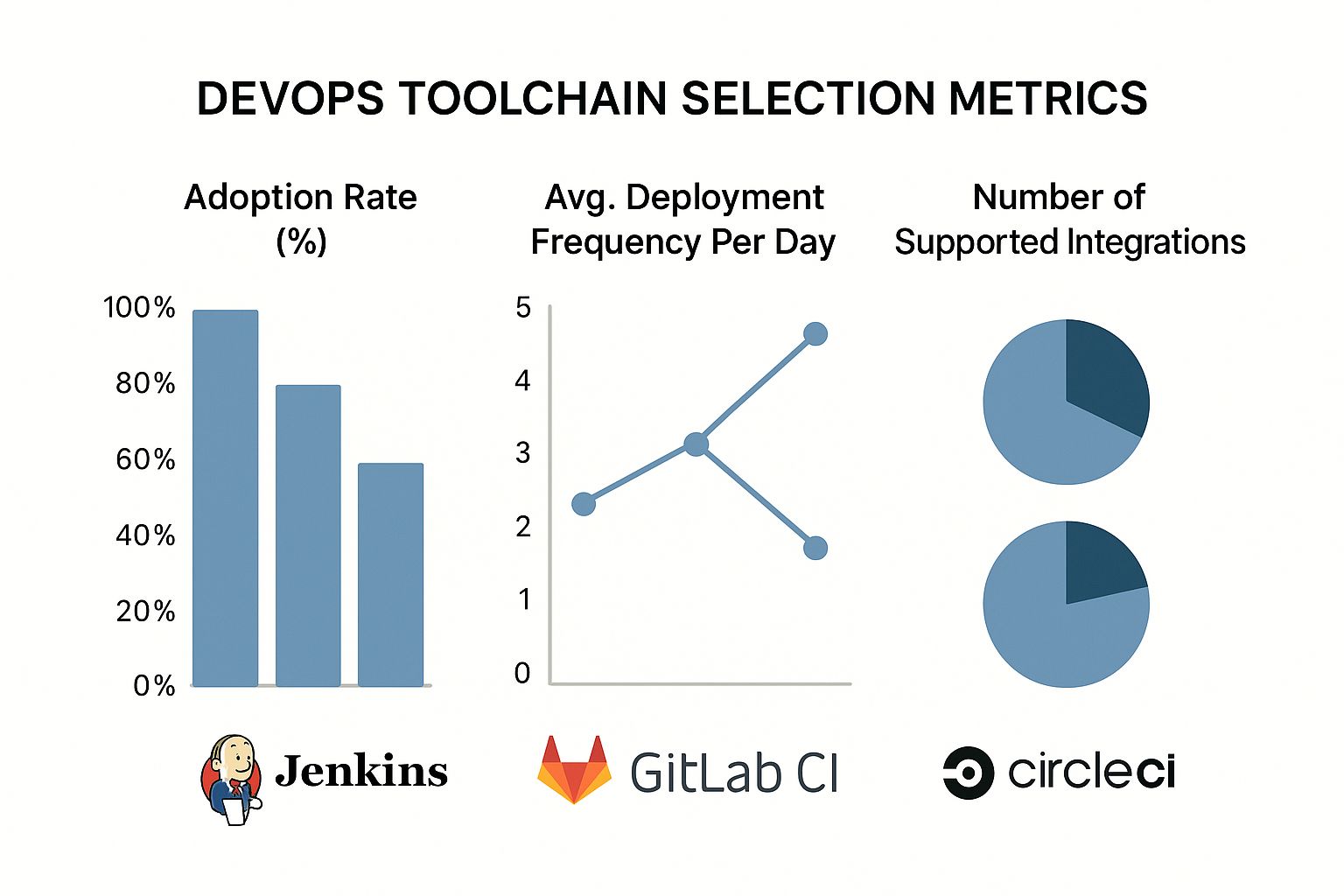Understanding The DevOps Transformation Landscape

Modern enterprises are increasingly adopting DevOps. This is largely driven by the need for faster delivery cycles, improved software quality, and enhanced team collaboration. Moving away from traditional development methods is crucial in today's fast-paced market. Organizations must adapt to these changes to remain competitive.
Adopting DevOps practices is vital because traditional divisions between development and operations teams often stifle innovation and impede progress. This understanding encourages businesses to embrace the collaborative and integrated nature of DevOps.
Cultural Shifts: The Heart of DevOps
A successful DevOps implementation hinges on a significant cultural shift. Teams need to transition from individual ownership to shared responsibility. This involves open communication, blameless retrospectives, and a continuous learning environment.
Cultivating a culture of automation and continuous improvement is also essential for maximizing the benefits of DevOps. This means utilizing tools and processes that streamline workflows and enable rapid feedback loops.
India's DevOps Landscape
The DevOps movement is rapidly gaining traction in India, fueled by the growing demand for cloud services. The cloud's inherent flexibility and scalability perfectly complement DevOps principles. This facilitates faster development, testing, and deployment processes.
The Indian DevOps market is poised for remarkable growth. It is projected to achieve a 19.48% CAGR from 2025 to 2033. This will see the market reach USD 2,566.9 million by 2033, up from USD 460.6 million in 2024. This demonstrates the increasing recognition of DevOps' value within the Indian region. For more insights into DevOps trends and statistics, check out this resource: DevOps Statistics
To illustrate this growth further, let's look at the projected market size and key drivers:
The following table provides a detailed overview of the projected growth of the DevOps market in India:
DevOps Market Growth Projections for India |
—|—
| Year | Market Size (USD Million) | Growth Rate (%) | Key Drivers |
|---|---|---|---|
| 2024 | 460.6 | – | Initial cloud adoption, increasing awareness of DevOps |
| 2025 | 550.7 | 19.55 | Growing demand for automation, increased focus on software quality |
| 2026 | 658.1 | 19.50 | Rise of DevSecOps, expanding cloud infrastructure |
| 2027 | 786.0 | 19.45 | Increased adoption of microservices architecture, skilled workforce growth |
| 2028 | 939.3 | 19.52 | Government initiatives promoting digital transformation |
| 2029 | 1,122.0 | 19.44 | Growing startup ecosystem embracing DevOps |
| 2030 | 1,340.3 | 19.47 | Increased investment in DevOps tools and technologies |
| 2031 | 1,602.2 | 19.55 | Maturing DevOps practices across industries |
| 2032 | 1,916.3 | 19.60 | Focus on continuous delivery and integration |
| 2033 | 2,291.8 | 19.61 | Widespread adoption of AI and ML in DevOps |
This table highlights the significant growth expected in the Indian DevOps market, driven by factors such as cloud adoption, automation, and the increasing need for faster software delivery.
Regulatory Considerations
Implementing a DevOps strategy also requires careful attention to regulatory compliance. Organizations in regulated industries must ensure their DevOps practices align with specific security and compliance standards.
This often involves integrating security measures throughout the development lifecycle, commonly referred to as DevSecOps. Addressing data privacy regulations and industry-specific guidelines is also crucial to mitigate potential legal and operational risks. Understanding these regulatory considerations early is essential for a seamless DevOps transformation.
Phase 1: Assessment And Foundation Building That Actually Works

Before implementing new tools and automated processes, ensure your DevOps implementation in India is built upon a solid foundation. This begins with a thorough assessment of your current operational landscape. This initial phase is critical, setting the stage for a successful DevOps transformation.
Evaluating Your Current Workflow
Start by carefully examining your current development workflows. Map your existing software delivery pipeline, from initial code commit to final deployment. Identify any bottlenecks or friction points that hinder your delivery cycle. Manual testing processes or overly complex deployment procedures, for example, can significantly slow down progress. This assessment helps pinpoint areas ripe for DevOps optimization.
Next, assess your existing infrastructure. Analyze its capacity, scalability, and compatibility with common DevOps tools like Jenkins or GitLab CI. Determine whether your current systems need upgrades or if migrating to cloud-based solutions like AWS or Azure would be beneficial. Understanding your infrastructure's limitations is essential for a seamless transition to DevOps.
Team Readiness And Buy-in
Evaluating your team's readiness for DevOps is paramount. Assess the existing skillset of your development and operations teams. Identify any gaps related to automation, CI/CD, or cloud technologies. Address these gaps with targeted training and mentorship programs.
Preparing your team to use new tools and processes effectively is key to successful DevOps adoption. Equally important is securing leadership buy-in. Present a compelling business case to stakeholders, emphasizing the benefits of DevOps. These advantages include faster delivery, improved quality, and increased efficiency.
DevOps implementation in India is a significant contributor to faster deployments and improved collaboration. Globally, 77% of organizations use DevOps practices to enhance software deployment efficiency. This trend is reflected in India's growing adoption of DevOps principles, focusing on automation, continuous integration, and continuous delivery. For further insights, explore these DevOps statistics. Strong leadership support secures the necessary resources and commitment for a successful DevOps transformation.
Establishing Baseline Metrics
Finally, establish clear baseline metrics. These metrics serve as benchmarks to track progress and demonstrate the return on your DevOps investment. Measure key performance indicators (KPIs) such as deployment frequency, lead time for changes, and change failure rate.
Tracking these metrics helps quantify the improvements achieved through DevOps. This data-driven approach provides tangible evidence of the transformation's success. A robust assessment and a strong foundation built on these principles are essential for launching a successful DevOps implementation. This foundational phase sets the tone for the entire DevOps journey and paves the way for lasting improvements in software delivery.
Phase 2: Strategic Tool Selection And Infrastructure Setup
A well-defined DevOps implementation roadmap requires careful planning around the tools and infrastructure supporting your automated processes. This strategic selection process is crucial, as the right tools can significantly enhance your team's productivity and the overall success of your DevOps journey. This phase prepares for efficient and scalable software delivery.
Choosing The Right Tools
The tools you select should align with your specific organizational needs, budget, and long-term goals. Start by identifying the key tool categories essential for your DevOps pipeline. These typically include:
-
Version Control Systems: Tools like Git allow for efficient code management and collaboration.
-
CI/CD Platforms: Platforms such as Jenkins, GitLab CI, and CircleCI automate the build, test, and deployment processes.
-
Containerization Technologies: Docker and Kubernetes enable consistent and scalable application deployment.
-
Monitoring Solutions: Tools like Prometheus and Grafana provide insights into system performance and health.
Open Source vs. Commercial
Choosing between open-source and commercial tools is a crucial decision. Open-source options often offer greater flexibility and community support, while commercial tools typically provide more advanced features and dedicated support. Factors to consider include:
-
Community Support: Is there an active community backing the open-source tool?
-
Scalability: Can the tool scale to meet your future needs?
-
Total Cost of Ownership: Consider not just the upfront cost, but also ongoing maintenance and support expenses.
To help illustrate the differences between some popular CI/CD tools, let’s take a look at their adoption rate, average deployment frequency, and the number of integrations they support.

As the infographic shows, Jenkins boasts a high adoption rate, while GitLab CI and CircleCI offer competitive advantages in terms of deployment frequency and integration capabilities. This highlights the need to select tools tailored to specific project requirements.
The following table provides a more detailed comparison of open-source and commercial DevOps tools, along with cost considerations and suitability for Indian enterprises.
To help you further evaluate your options, the table below offers a comprehensive comparison:
DevOps Tool Selection Matrix for Indian Enterprises: Comprehensive comparison of popular DevOps tools with cost analysis and suitability for Indian market conditions
| Tool Category | Open Source Option | Commercial Option | Cost (INR) | Best For |
|---|---|---|---|---|
| Version Control | Git | GitHub Enterprise | Varies based on users and features | Enterprises needing advanced collaboration and security features |
| CI/CD | Jenkins | GitLab CI Premium | Varies based on users and features | Organizations prioritizing robust CI/CD pipelines |
| Containerization | Kubernetes | OpenShift | Varies based on usage and support level | Enterprises seeking managed Kubernetes solutions |
| Monitoring | Prometheus | Datadog | Varies based on data ingestion and features | Businesses requiring comprehensive monitoring and observability |
This table provides a starting point for evaluating DevOps tools based on individual business requirements and budget constraints. It highlights the trade-offs between cost and features when choosing between open-source and commercial solutions.
Infrastructure as Code (IaC)
Implementing Infrastructure as Code (IaC) is vital for creating scalable and secure environments. IaC involves managing and provisioning infrastructure through code, using tools like Terraform or Ansible. This practice:
-
Increases Efficiency: Automates infrastructure management tasks.
-
Improves Consistency: Ensures consistent environments across development, testing, and production.
-
Enhances Security: Reduces the risk of human error and enhances security through automated compliance checks.
Implementing IaC requires careful planning and integration with your chosen toolchain. This ensures your development, testing, and production environments are consistent, scalable, and cost-efficient. By building the right infrastructure and selecting the right toolset, you're setting a solid foundation for your DevOps pipeline and the subsequent stages of implementation.
Phase 3: Building Automation Pipelines That Scale
This phase signifies the shift from planning to execution in your DevOps roadmap. Here, automation fundamentally changes how your teams work. It involves creating CI/CD pipelines that address real-world project complexities while maintaining speed and dependability.
Designing Robust CI/CD Pipelines
At the core of this phase lies the construction of efficient CI/CD pipelines. Imagine it as an automated assembly line for your software. Each stage, from code integration and testing to deployment, is automated, resulting in a faster and more reliable process.
This involves automating essential procedures like testing, code quality analysis, and security scans. However, it's crucial to design these automated processes thoughtfully. They should improve efficiency without creating new bottlenecks or sacrificing adaptability.
Implementing Effective Automation Strategies
Successful teams employ strategies like parallel processing. This enables the simultaneous execution of multiple tasks, significantly accelerating the pipeline. Efficient artifact management, ensuring correct storage and version control of software components, is another critical element.
Furthermore, environment promotion strategies facilitate the movement of code through different stages, from development to testing and ultimately, production. These strategies offer a consistent and regulated approach for managing your application across various environments.
Minimizing Downtime and Risk
Automation also plays a vital role in reducing downtime and risk. Automated rollback mechanisms can swiftly revert to a prior stable version if a deployment faces issues. Techniques like blue-green deployments—alternating between two identical environments—minimize disruption during deployments.
Automated disaster recovery processes are critical for maintaining business continuity. These automated systems help rapidly restore services in case of unforeseen outages or failures, lessening the effect on your operations.
AWS CodePipeline Deep Dive
For a practical illustration of implementing a strong CI/CD pipeline, explore our guide on accelerating DevOps delivery with a deep dive into AWS CodePipeline. This will help you convert these strategies into practical steps for your team. By prioritizing these elements, you can establish an automated pipeline that scales effectively while maintaining stability and resilience. This paves the way for incorporating crucial security and monitoring elements, furthering your DevOps journey.
Phase 4: Integrating Security And Monitoring From Day One

Security and monitoring are crucial for successful DevOps. These aren't just afterthoughts, but foundational pieces, especially in regions with growing data privacy and compliance regulations like India. This phase focuses on building robust systems to protect your organization and your customers.
Implementing Comprehensive Monitoring
Comprehensive monitoring provides crucial insights into your systems. This involves setting up tools that offer clear visibility into application performance, infrastructure health, and key user experience metrics. Monitoring is about gaining actionable insights, not just collecting data.
Think of your monitoring system as your DevOps pipeline's central nervous system. It constantly gathers system health and performance information, allowing you to identify and address potential problems before they affect your users.
This proactive approach shifts you from reactive problem-solving to proactive issue resolution. Effective monitoring enables faster responses, minimizes disruptions, and improves user experience. This shift from reaction to prevention is key for DevOps success.
Integrating Security Practices
Integrating security isn't just a good idea, it's essential. This means implementing automated security testing, regular vulnerability scanning, and automated compliance checking. This approach keeps you aligned with evolving regulatory landscapes and data privacy standards.
Automated security testing should be part of your CI/CD pipeline. Imagine every code change undergoing rigorous, automatic security checks, identifying vulnerabilities early in development. This prevents security issues from reaching production.
Regular vulnerability scans are also critical. These scans act like continuous health checks for your systems, proactively finding weaknesses that could be exploited. For further insights into securing cloud-native DevOps, see: Signiance Technologies' Approach.
Embracing DevSecOps
Seamless security integration into your development lifecycle is often called DevSecOps. This approach builds security into every development stage, fostering a culture of shared responsibility. Everyone, from developers to operations, is accountable for system security.
DevSecOps isn't about slowing down development; it's about building secure systems from the start. It's about integrating security without sacrificing the speed and agility of DevOps. This proactive approach protects your organization and customers while maintaining development velocity.
By prioritizing security and monitoring from the outset, you build a strong foundation for your DevOps implementation. This proactive approach reduces risk, ensures compliance, and builds a more resilient system adaptable to future challenges. This lays the groundwork for measuring success and continuous improvement.
Measuring Success and Driving Continuous Improvement
After implementing the phases of your DevOps implementation roadmap, the journey isn't over. True success lies in continuous evaluation and improvement. This means establishing key performance indicators (KPIs) that demonstrate a tangible return on investment (ROI) for your DevOps initiatives. This phase focuses on refining processes and maximizing value.
Defining and Tracking KPIs
Start by identifying KPIs aligned with your business goals. These KPIs should offer quantifiable insights into key areas:
- Deployment Frequency: How often is new code deployed to production?
- Change Failure Rate: What percentage of deployments cause production issues?
- Mean Time to Recovery (MTTR): How quickly can production problems be resolved?
These metrics offer a clear picture of your DevOps effectiveness, showcasing the speed, reliability, and resilience of your software delivery. This data-driven approach provides a concrete understanding of DevOps's business impact.
Evidence-Based Improvement
Gathering and analyzing data is crucial for informed decision-making. Evidence-based practices help to:
- Pinpoint Bottlenecks: Identify areas hindering workflow efficiency.
- Optimize Performance: Make targeted improvements to pipelines and processes.
- Enhance Customer Satisfaction: Ultimately, improved speed and reliability create a better user experience.
This approach ensures continuous evolution and improvement. It cultivates a culture of continuous growth, essential for long-term success.
The success of DevOps implementation can be measured by examining global trends and applying them locally. Research from DORA reveals organizations embracing DevOps achieve a 208x increase in code deployments and a 2,604x faster lead time for changes compared to less agile counterparts. Discover more insights about the impact of DevOps here. This highlights the potential for significant improvement.
Fostering a Culture of Continuous Learning
Effective DevOps is a continuous cycle, incorporating:
- Regular Retrospectives: Frequent team discussions to identify improvements and share best practices.
- Feedback Loops: Systems for gathering input from all stakeholders.
- Continuous Learning: A culture of experimentation and learning from both successes and failures.
This iterative process fosters a culture of continuous improvement. It shifts DevOps from a set of practices to a mindset, keeping your organization ahead of the curve and adaptable to change.
Scaling DevOps Practices
Scaling DevOps across multiple teams requires:
- Standardized Processes: Consistent workflows and best practices across the organization.
- Knowledge Sharing: Collaboration and cross-team communication to spread DevOps principles.
- Centralized Tooling: Tools that enable collaboration and automation across all teams.
Implementing these strategies creates a foundation for scalable and consistent DevOps practices, extending benefits across the organization and maximizing your investment. This structured approach ensures consistent application of DevOps principles for long-term success.
Key Takeaways And Success Strategies
A successful DevOps implementation requires a well-defined roadmap and a commitment to continuous improvement. This section distills key takeaways from our discussion and provides practical strategies for addressing the challenges of DevOps transformation. It's about turning insights into actionable steps.
Overcoming Common Pitfalls
Many organizations face obstacles during their DevOps journey. However, these can be effectively addressed with proactive planning and a focus on fundamental principles:
-
Resistance to Change: Address this by fostering open communication and demonstrating DevOps' value through pilot projects and clear metrics. Targeted training programs can also help teams adapt to new processes and technologies.
-
Siloed Implementation: Promote cross-functional collaboration by establishing clear roles and responsibilities. Implement tools like Slack that facilitate communication between teams.
-
Tool Obsession: Tools should support your processes, not define them. Choose tools that align with your organizational needs and avoid unnecessary complexity. Prioritize process and culture.
-
Neglecting Security: Integrate security practices from the beginning. Adopt DevSecOps to ensure security is embedded throughout the development lifecycle.
Building a Culture of Success
DevOps flourishes in a culture of shared responsibility, continuous learning, and open communication. This requires active leadership and a commitment to building a supportive environment:
-
Leadership Buy-in: Secure leadership support to ensure resources and long-term commitment to the DevOps transformation. Leaders should actively champion DevOps principles.
-
Continuous Improvement: Implement feedback loops and regular retrospectives to identify areas for optimization. This fosters a culture of continuous learning and improvement.
-
Knowledge Sharing: Encourage knowledge sharing across teams to ensure the consistent implementation of best practices. This helps scale DevOps across the organization.
Measuring Success and Demonstrating ROI
Track key performance indicators (KPIs) aligned with your business goals to understand the impact of your DevOps implementation. This data-driven approach demonstrates the benefits of your investment:
-
Deployment Frequency: Measure how often new code is deployed to production. This demonstrates the increased agility achieved through DevOps.
-
Lead Time for Changes: Track the time it takes for changes to reach production, highlighting improvements in efficiency.
-
Change Failure Rate: Monitor the percentage of deployments that cause issues, showcasing the increased reliability of your software delivery.
By focusing on these metrics, you can quantify the value of DevOps and demonstrate its contribution to business success. These tangible results showcase ROI and reinforce the importance of DevOps initiatives.
Practical Implementation Roadmap
The following table provides a concise overview of the key phases of a DevOps implementation roadmap, including timelines and actionable steps:
| Phase | Timeline | Key Actions |
|---|---|---|
| Assessment and Foundation Building | 2-4 weeks | Evaluate current processes, identify bottlenecks, establish baseline metrics, secure leadership buy-in |
| Tool Selection and Infrastructure Setup | 4-6 weeks | Select tools based on needs and budget, implement Infrastructure as Code (IaC), establish automated infrastructure provisioning |
| Building Automation Pipelines | 6-8 weeks | Design and implement CI/CD pipelines, automate testing and deployments, establish automated rollback mechanisms |
| Integrating Security and Monitoring | 4-6 weeks | Implement DevSecOps practices, integrate security testing and monitoring tools, establish alerting mechanisms |
| Measuring Success and Continuous Improvement | Ongoing | Track KPIs, conduct regular retrospectives, implement feedback loops, foster a culture of continuous learning |
This practical roadmap provides a clear framework for implementing DevOps. It guides you through the essential phases of transformation and sets the stage for continuous improvement. By following this roadmap, organizations can build a robust and scalable DevOps strategy.
Ready to begin your DevOps transformation? Signiance Technologies offers the expertise and support you need to navigate this process successfully. Our services, from cloud architecture design to automated DevOps pipelines, empower your organization to unlock DevOps' full potential. Contact Signiance Technologies today to achieve your DevOps goals: https://signiance.com
